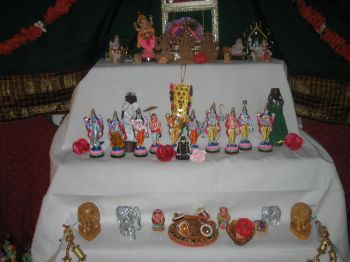Holidays are here.
Maybe not in the US and other Western countries, yet.
But, in India, the festival season has already swung into action with the onset of Navarathri and Durga Puja.
The next big festival of course is Deepavali or Diwali – the festival of lights. This is one occasion that people of all faiths celebrate. Although Diwali has its roots in Hindu mythology, the manner in which it is celebrated is such that people of all faiths and walks of life join in the festivities.
Diwali Preparations
Celebrations include meticulous planning of family meals. Exotic sweet dishes and savories are prepared for the occasion in large quantities to be shared with neighbors and friends. People clean their homes(much like spring cleaning), and beautify it in preparation for Diwali. Walls are washed and painted. Festoons and flowers are used to decorate walls, ceilings, door frames and windows. Earthen lamps are brought out, washed, cleaned and set out to dry in the sun. Some are even decorated with paint. Families, especially those with young children purchase several packs of fire crackers and sparklers weeks in advance. Children find it exciting to discover the latest fire crackers on the market and compete with each other, showing off their best buys.
Diwali Eve
Celebrations officially begin on Diwali eve. Women dressed in their finest traditional garments, light up dozens of earthen lamps. They fill them with oil or ghee and after lighting them, carry them on trays to different parts of the house and set them down in decorative arrangements. The front porch, backyard, window sills, doorways, roofs, balconies – all take on a beautiful glow, adorned with rows and rows of lamps. Rangolis or colorful, floral patterns are created on the floor in front of the house and in other prominent places. Guests begin arriving. Families come out into the courtyard or street to enjoy a display of fire crackers and to greet each other.
Diwali Day
In some parts of India Diwali begins with a Mangal Snaan (Holy Bath.) People awake at dawn and apply oil to their hair and body before bathing. Wearing new clothes, they offer prayers before going out to meet friends and family and participating in a fireworks display. A grand feast is prepared and the whole family, including members of the extended family, meets for lunch. Some visit temples or other relatives during the day to
share sweet dishes and to exchange gifts and greetings.
In other places, Diwali celebrations begin only at dusk. People gather to greet each other and enjoy a family dinner. This is followed by partying and games. A popular custom is that of playing cards through the night. In North India, this is considered auspicious and a means to invoke Goddess Lakshmi who represents wealth. Diwali is considered to mark the beginning of the new year and thus, people pray for a year of good fortune.
New movies come to theatres on Diwali day in most Indian states. People throng the theatres to catch the first show. The past decade has seen a decline in families going out and celebrating Diwali with friends and family as specially produced Diwali themed TV shows claim their time.
Free Diwali Ecards
No matter how you celebrate Diwali, sending a free ecard will only take a minute. It tells your loved ones that you’re thinking of them on the auspicious occasion. Our animated Diwali ecards represent all the wonderful aspects of the festival from Rangolis to rows of lamps, fireworks to sharing boxes of sweets. So, even if you’re not celebrating Diwali with family, our free ecards serve as a reminder of each its beautiful elements. And if you are, then, there’s no better way to reinforce the Diwali spirit than with a free ecard.
 Recently I came across some interesting facts about greeting cards some of them are listed below.
Recently I came across some interesting facts about greeting cards some of them are listed below. Have you sent out
Have you sent out 
